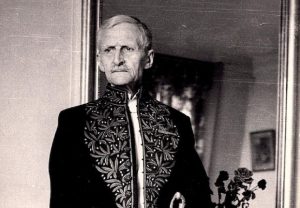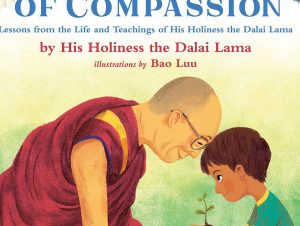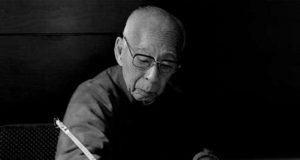A person already in darkness who
(The Buddha’s teaching on the Four Types of Person, AN 4.85)
because of misconduct is headed for greater darkness;
A person already in darkness who
because of virtuous conduct is headed for light;
A person already in light who
because of negative actions and conduct is headed for darkness;
A person already in the light who
conducts themselves with virtue and is headed back into the light.

Phra Khru Baitika Dr. Barton Yanathiro (28 January 1936–22 June 2011), also known as Phra Bart or Dr. Bart, was one of the pre-eminent Dhamma teachers and meditation masters of the modern era. Throughout his life, Dr. Bart accumulated wisdom and instructed his students, devotees, and followers in discerning the truth. Through his noble guidance on the righteous path, he imparted a breadth of knowledge, insight, wisdom, and deep practice.

Born on an auspicious Tuesday, 28 January 1936, Phra Bart brought a light of joy to this green planet. Dr. Bart was an American Buddhist monk, a former professor, and an international development specialist, with a PhD in Sociology and Social Psychology from Cornell University. When he was young, Dr. Bart was impressed by the depth of the Buddha’s wisdom and practiced approach. He frequently mentioned that the Buddha’s deepened understanding of the Four Noble Truths, the Eightfold Noble Path, the doctrine of dependent origination, and the four foundations of mindfulness joyously motivated him to explore the Dhamma over six decades.

Inspired by the most Venerable Dr. Phrathepyanmonkol, Dr. Bart was ordained as a monk (bhikkhu) at Wat Luang Phor Sodh Dhammakayaram on 6 March 2002. He developed international meditation retreats and taught thousands of meditators around the world during his nine years as a monk. In addition, he hosted Sunday Dhamma Talks and ran an English program for monastic members. Dr. Bart was also the head of the translation team, responsible for several Buddhist publications, including the Three Trainings on the Path of Purification, Samatha-Vipassana Meditation, and the Series of Sunday Dhamma Talks. Dr. Bart drew his last breath at Wat Luang Phor Sodh Dhammakayaram on Wednesday, 22 June 2011.

Dr. Bart was incredibly devoted to his Dhamma practice and monastic responsibilities. He finished his monumental book project, Samatha-Vipassana Meditation, just three days before he passed away. The late abbot of Wat Luang Phor Sodh Dhammakayaram, Ven. Dr. Phrathepyanmonkol, acknowledged his noble contribution in the introductory section of the groundbreaking Theravada book Samatha-Vipassana Meditation:*
I would like to acknowledge the efforts of the contributors who worked patiently with me to make this book possible, especially Phra Khru Baitika Dr. Barton Yanathiro, who completed his last excellent work just three days before he passed away. Without him, this book would never be completed.
(Thepyanmonkol 2012, p. xii)
A brief account of the monastic life of Dr. Bart has been shared on the official YouTube channel of Wat Luang Phor Sodh:
Dr. Bart’s legacy also had a profound impact on my own life, as it had on many other practitioners and devotees. I consider the years I experienced with an admired teacher to be the finest of my life. I humbly express my appreciation to Dr. Bart, who patiently taught me the Dhamma, guided me through mindfulness meditation, and provided me with clear instructions on how to follow the path of awakening. I honor his memory by sharing his insightful teachings on “Stop Still” and “The Beauty of the Breath,” which I convey with a heart full of gratitude.


The term “Stop Still” was frequently used by Dr. Bart. I once inquired about the meaning of this phrase, “Stop Still.” Dr. Bart responded that the mind is fickle and restless, and that many thoughts proliferate. Bringing the mind to a level of steadiness and calm is quite crucial. Through mindfulness training, one can overcome desires, hatred, and delusions, as well as wandering inclinations and mental amplification. “Stop Still” is a mantra that instructs us to bring our minds back to the present moment and to put an end to the mind’s propensity to wander.

On one occasion, Dr. Bart organized a three-day retreat with a group of students on a beach in southern Thailand. During that time, I was a little apprehensive about spending the night on the beach. Out of compassion, Dr. Bart encouraged me to remain with him in a large tent. I consider myself blessed to have had such a pleasurable interaction with Dr. Bart, who provided me with sound advice and unwavering compassion and fatherly care. For the beach nights, Dr. Bart and I shared the same tent. During the night, the full moon shone brightly above the ocean and I was captivated by its beauty.
The next day, Dr. Bart meditated first thing in the morning. When I awoke, I took my cushion and sat beside him on the beach. The Sun was rising in the east as I closed my eyes to meditate. The Sun had moved exactly above me, and its rays shored over the ocean at the end of my meditation. After exchanging morning greetings, I told Dr. Bart about my feelings: “It’s a lovely morning, Ajahn Bart. I value our morning reflection on the beach.”
“Sanjoy, did you notice how gloomy it was while we closed our eyes for the inward journey?” Dr. Bart remarked. The Moon was still shining brightly and the Sun was rising in the east. We observed that the Sun had already risen when we opened our eyes at the end of our meditation. It had been such a magnificent and blissful moment!
Dr, Bart further said: “You would recognize the beauty of our morning contemplation if you could see into your heart clearly.” All of the beauty is contained in your breath. Every day is an opportunity to reflect and clarify our views, as long as we have the capacity to take a breath. Every day is a complete delight. Each of your moments and breaths radiates in a beautiful and wholesome manner when the mind is stable and free of its underlying defilements. All beauty resides in your mind—all beauty is in your breath.”



Throughout his life, Dr. Bart graciously imparted mindfulness meditation and Dhamma teachings to seekers and devotees. Dr. Bart was, without a doubt, an inspiration as he had been diligently caring for the light of awakening and spreading the bliss of wisdom with an enormous number of pupils. As a pupil of Dr. Bart, I owe him my humble gratitude and utmost respect for his dedication to the path of awakening.
May the legacy of Dr. Bart inspire us on the path of awakening.
May Dr. Bart attain the bliss of Nibbana.
* A pdf version of Samatha-Vipassana Meditation is available at http://www.dhammacenter.org.
References
Bodhi, Bhikkhu. Trans. 2000. The Connected Discourses of the Buddha. Boston: Wisdom Publications.
Thepyanmongkol, Phra. 2012. Samatha-Vipassana Meditation. Nakhon Pathom: Petkasem Printing Group.
Rajyanvisith, Phra. 2012. Sunday Dhamma Talk (Vol 1–7). Ratchaburi: Wat Luang Phor Sodh Dhammakayaram.
Related features from BDG
Nurturing the Roots of the Thai Forest Lineage in Britain: A Short Conversation with Ajahn Sucitto
Ajahn Sucitto, Down to Earth
Ajahn Sona, Off the Grid
On Technology and Human Connection: An Interview with Ajahn Brahm
Happiness, Expectations, and Learning to be Losers: An Interview with Ajahn Brahm
Related news reports from BDG
Ajahn Vayama, Pioneering Australian Buddhist Nun, Dies Aged 70
Thai Buddhist Leader Mae Chee Sansanee Sthirasuta Dies Aged 68











